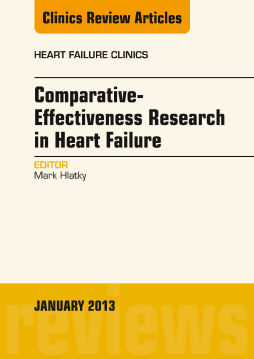
BOOK
Comparative-Effectiveness Research in Heart Failure, An Issue of Heart Failure Clinics, E-Book
(2013)
Additional Information
Book Details
Abstract
This issue of Heart Failure Clinics covers comparative-effectiveness research in heart failure. Expert authors review the most current information available about the comparative effectiveness of different treatments for heart failure, including drug treatments, cardioverter defibrillators and cardiac resynchronization therapy, as well as patient adherence. Keep up-to-the-minute with the latest developments in comparative-effectiveness research.
Table of Contents
| Section Title | Page | Action | Price |
|---|---|---|---|
| Front Cover | Cover | ||
| Heart Failure Clinics: Comparative-Effectiveness Research in Heart Failure | i | ||
| Copyright Page | ii | ||
| Table of Contents | v | ||
| Contributors | iii | ||
| HEART FAILURE CLINICS | vii | ||
| Preface: Comparative Effectiveness\rResearch in Heart Failure | ix | ||
| Chapter 1. Data Sources for Heart Failure Comparative Effectiveness Research | 1 | ||
| GENERAL DATA NEEDS FOR CER | 1 | ||
| CLINICAL REGISTRIES | 2 | ||
| RCT DATABASES | 6 | ||
| ADMINISTRATIVE DATA | 6 | ||
| ELECTRONIC HEALTH RECORDS | 9 | ||
| DATABASE LINKAGE | 9 | ||
| SUMMARY | 10 | ||
| REFERENCES | 10 | ||
| Chapter 2. End Points for Comparative Effectiveness Research in Heart Failure | 15 | ||
| INTRODUCTION | 15 | ||
| DEFINITIONS AND OVERALL CONSIDERATIONS | 16 | ||
| VITAL STATUS | 16 | ||
| HEALTH STATUS | 18 | ||
| COST | 22 | ||
| HOSPITALIZATION | 23 | ||
| SAFETY | 23 | ||
| SURROGATES | 24 | ||
| COMBINING END POINTS | 25 | ||
| CONSIDERATIONS FOR FUTURE END-POINT DESIGN | 25 | ||
| SUMMARY | 26 | ||
| ACKNOWLEDGMENTS | 26 | ||
| REFERENCES | 26 | ||
| Chapter 3. Epidemiologic and Statistical Methods for Comparative Effectiveness Research | 29 | ||
| RANDOMIZED TRIALS | 29 | ||
| DATA QUALIT | 30 | ||
| NEW-USER DESIGNS | 31 | ||
| OVERVIEW OF STATISTICAL METHODS TO CONTROL CONFOUNDING | 31 | ||
| PROPENSITY SCORES | 31 | ||
| MARGINAL STRUCTURAL MODELS | 34 | ||
| INSTRUMENTAL VARIABLES | 34 | ||
| SUMMARY | 35 | ||
| REFERENCES | 35 | ||
| Chapter 4. Comparative Effectiveness Research: Drug-Drug Comparisons in Heart Failure | 37 | ||
| INTRODUCTION | 37 | ||
| DEFINITION OF DRUG-DRUG CER | 38 | ||
| METHODOLOGIC ISSUES OF DRUG-DRUG CER | 38 | ||
| STRENGTHS AND LIMITATIONS OF DRUG-DRUG CER | 42 | ||
| DRUG-DRUG CER IN HF | 43 | ||
| SUMMARY | 46 | ||
| REFERENCES | 46 | ||
| Chapter 5. Heart Failure Patient Adherence: Epidemiology, Cause, and Treatment | 49 | ||
| ADHERENCE | 49 | ||
| FACTORS AFFECTING ADHERENCE | 52 | ||
| INTERVENTIONS TO IMPROVE ADHERENCE | 53 | ||
| SUMMARY | 56 | ||
| REFERENCES | 56 | ||
| Chapter 6. Effectiveness of Implantable Cardioverter Defibrillators and Cardiac Resynchronization Therapy in Heart Failure | 59 | ||
| INTRODUCTION | 59 | ||
| CLINICAL TRIALS EVALUATING ICD THERAPY FOR PRIMARY PREVENTION OF SCD IN ISCHEMIC HF | 64 | ||
| CLINICAL TRIALS EVALUATING ICD THERAPY FOR PRIMARY PREVENTION OF SCD IN HF EARLY AFTER MI OR CORONARY REVASCULARIZATION | 64 | ||
| CLINICAL TRIALS EVALUATING ICD THERAPY FOR PRIMARY PREVENTION OF SCD IN NONISCHEMIC HF | 65 | ||
| CLINICAL TRIALS EVALUATING ICD THERAPY FOR SECONDARY PREVENTION OF SCD IN HF | 66 | ||
| SECONDARY ANALYSES OF RANDOMIZED CONTROLLED TRIALS AND OBSERVATIONAL STUDIES EVALUATING ICD THERAPY FOR PRIMARY PREVENTION IN HF SUBGROUPS | 66 | ||
| SINGLE-LEAD VERSUS DUAL-LEAD ICDS | 67 | ||
| OBSERVATIONAL STUDIES EVALUATING ICD-RELATED COMPLICATIONS | 70 | ||
| CLINICAL TRIAL EVALUATING CARDIAC RESYNCHRONIZATION THERAPY IN MODERATE TO SEVERE HF | 70 | ||
| CLINICAL TRIALS EVALUATING CRT IN PATIENTS WITH MILDLY SYMPTOMATIC HF | 71 | ||
| SECONDARY ANALYSES OF RCTS AND OBSERVATIONAL STUDIES EVALUATING CRT IN SUBGROUPS | 72 | ||
| GUIDELINE RECOMMENDATIONS | 73 | ||
| SUMMARY | 73 | ||
| REFERENCES | 73 | ||
| Chapter 7. Comparative Effectiveness Research in Heart Failure Therapies: Women, Elderly Patients, and Patients with Kidney Disease | 79 | ||
| INTRODUCTION | 79 | ||
| METHODOLOGICAL CONSIDERATIONS FOR CER | 80 | ||
| WOMEN | 80 | ||
| ELDERLY PATIENTS | 82 | ||
| KIDNEY DISEASE | 86 | ||
| CONCLUDING REMARKS | 89 | ||
| REFERENCES | 89 | ||
| Chapter 8. The Economics of Heart Failure | 93 | ||
| BACKGROUND | 93 | ||
| HEALTH ECONOMICS 101 | 94 | ||
| COST-EFFECTIVENESS ANALYSES | 94 | ||
| COST-EFFECTIVENESS IN HEART FAILURE | 97 | ||
| DISCUSSION | 103 | ||
| REFERENCES | 103 | ||
| Index | 107 |
